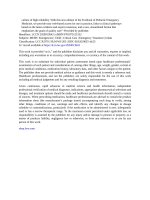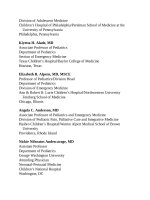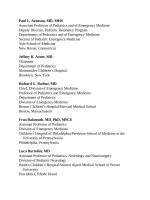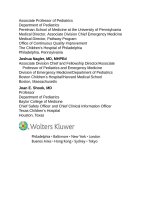Pediatric emergency medicine trisk 2720 2720
Bạn đang xem bản rút gọn của tài liệu. Xem và tải ngay bản đầy đủ của tài liệu tại đây (161.71 KB, 1 trang )
Administration of broad-spectrum antibiotics within 1 hour of presentation
to the ED has been shown to reduce morbidity and mortality from sepsis
in the setting of neutropenia.
Digital rectal examinations and rectal temperature measurements should
not be performed in neutropenic patients, as these procedures increase
the risk of bacterial translocation from the intestinal tract into the
bloodstream.
Though fever should raise concern for infection, the absence of fever
does not exclude the possibility of infection, particularly in patients on
high-dose steroids and/or with hypothalamic dysfunction from tumor.
Neutropenic patients may not generate erythema or purulence at the site
of localized infections.
Current Evidence
Fever in a neutropenic patient is a true emergency, even in a well-appearing patient (
Fig. 98.4 ). Identification of infection can be challenging because typical symptoms
may be absent or decreased. The depth and duration of neutropenia helps to predict
the risk of serious infections. All patients with an ANC below 500 or with a rapidly
falling ANC that will shortly be below 500 should be considered at risk. Although
fever itself can be a manifestation of some cancers, this is a diagnosis of exclusion,
particularly in a patient with neutropenia. While fever should certainly raise concern
for infection, the absence of fever should not overly reassure the clinician. Fever
may be absent or minimized in patients on high-dose steroids and/or patients with
hypothalamic dysfunction from tumor. In addition, localizing signs of infection may
be blunted because the lack of neutrophils prevents many of the usual manifestations
such as pus, significant local erythema, or edema.
One of the infectious risks attributable to the immunosuppression of
chemotherapy is Pneumocystis jirovecii (formerly known as Pneumocystis carinii )
pneumonia. Patients younger than 1 year and those receiving treatment for leukemia
or high-stage lymphoma are at increased risk. Most, if not all, pediatric oncology
patients are treated with prophylactic trimethoprim-sulfamethoxazole to prevent this
infection. Those who do not tolerate trimethoprim-sulfamethoxazole are on secondline agents such as atovaquone, dapsone, or pentamidine.
Prophylaxis for other infections varies by condition and center. Fungal
prophylaxis is increasingly common with specific regimens associated with a high
frequency of fungal disease. For example, many patients with acute myelogenous
leukemia take prophylactic antifungals throughout their treatment. Respiratory









